You are using an out of date browser. It may not display this or other websites correctly.
You should upgrade or use an alternative browser.
You should upgrade or use an alternative browser.
Dead ONIX OA21 Power on LED
- Thread starter BrothersInArms
- Start date
Is that the same finger Onix gave to many of its customers?
I hope the crook AW is done with anything audio
Hope not he is about to scam people in other branches where warnings not arrived
Stuart Frazer
pfm Member
A bit of Onix OA21 history from the designer himself, Tony Brady:
OA21A was the original OA20 put into a wider box to make it easier to make - the OA20 was tight!
OA21B had a LM317T regulator instead of a gyrator supply for the pre amp. both were 75W.
OA21C the power was dropped to 50W as we found a lower voltage but higher current transformer sounded better. sliding bias added, as the output level increased so did the bias up to a point. input switching was done by relays instead of the rotary switch of the previous versions. All above had din connectors
OA21D - RCA phono inputs instead of din. probably some more changes but I'd have to look through the pile of paper to find out what, all a long time ago
OA21E - power amp circuit revision which was also done on later D versions by putting some resistors in series with some transistor legs - not easy to do so we changed the board. might have been a couple of other changes
OA21S - fuses removed and an over-current trip board used instead. sliding bias of previous versions removed. input switching now by alps slide switch replacing the relays except for mute
Tony Brady is now Chief Engineer at Exposure Electronics. Where he can, he will service/repair the older original Onix products he designed.
OA21A was the original OA20 put into a wider box to make it easier to make - the OA20 was tight!
OA21B had a LM317T regulator instead of a gyrator supply for the pre amp. both were 75W.
OA21C the power was dropped to 50W as we found a lower voltage but higher current transformer sounded better. sliding bias added, as the output level increased so did the bias up to a point. input switching was done by relays instead of the rotary switch of the previous versions. All above had din connectors
OA21D - RCA phono inputs instead of din. probably some more changes but I'd have to look through the pile of paper to find out what, all a long time ago
OA21E - power amp circuit revision which was also done on later D versions by putting some resistors in series with some transistor legs - not easy to do so we changed the board. might have been a couple of other changes
OA21S - fuses removed and an over-current trip board used instead. sliding bias of previous versions removed. input switching now by alps slide switch replacing the relays except for mute
Tony Brady is now Chief Engineer at Exposure Electronics. Where he can, he will service/repair the older original Onix products he designed.
Craig B
Re:trophile
Mini XLR has a plug sleeve diameter of circa 8.4mm vs. standard Cannon/XLR at circa 15.8mm. Easy enough to measure the inside diameter of the socket round back of one's amp.It is definitely not mini-XLR, sorry boys. I don't know myself what connector it actually is though. But at least it saves people ordering mini-XLR plugs and being disappointed!
Craig B
Re:trophile
Sorry, I've just now seen your linked to picture of the DIN sockets, confirming that they all are 180º pattern.I believe so
For reference, DIN pin diameter is 1.45mm, so either fabricate two solid wire U-shaped links of this size, or source a male 180º plug and solder solid wire links across the appropriate pins. In either case, following the pattern depicted back in post #37.
Here is a Naim DIN4 link plug with the cover off. Basically the pin core of a Preh DIN4 plug assembly. With DIN5 180º you'll want to make sure that the link between pins 4 and 5 does not come into contact with pin 2 (at bottom centre) else that channel possibly be shorted to ground.

https://www.prehkeytec.com/fileadmin/user_upload/global/products/DIN-Connectors/71408/71408-050.pdf
tenpercenter
Don't ya rile 'em.....
Yep definitely 180
Thanks. Mine was made in January 1983 and I don’t know if the timeline can be linked to this?
That makes sense - many thanks
A bit of Onix OA21 history from the designer himself, Tony Brady:
OA21A was the original OA20 put into a wider box to make it easier to make - the OA20 was tight!
OA21B had a LM317T regulator instead of a gyrator supply for the pre amp. both were 75W.
OA21C the power was dropped to 50W as we found a lower voltage but higher current transformer sounded better. sliding bias added, as the output level increased so did the bias up to a point. input switching was done by relays instead of the rotary switch of the previous versions. All above had din connectors
OA21D - RCA phono inputs instead of din. probably some more changes but I'd have to look through the pile of paper to find out what, all a long time ago
OA21E - power amp circuit revision which was also done on later D versions by putting some resistors in series with some transistor legs - not easy to do so we changed the board. might have been a couple of other changes
OA21S - fuses removed and an over-current trip board used instead. sliding bias of previous versions removed. input switching now by alps slide switch replacing the relays except for mute
Tony Brady is now Chief Engineer at Exposure Electronics. Where he can, he will service/repair the older original Onix products he designed.
Thanks. Mine was made in January 1983 and I don’t know if the timeline can be linked to this?
Sorry, I've just now seen your linked to picture of the DIN sockets, confirming that they all are 180º pattern.
For reference, DIN pin diameter is 1.45mm, so either fabricate two solid wire U-shaped links of this size, or source a male 180º plug and solder solid wire links across the appropriate pins. In either case, following the pattern depicted back in post #37.
Here is a Naim DIN4 link plug with the cover off. Basically the pin core of a Preh DIN4 plug assembly. With DIN5 180º you'll want to make sure that the link between pins 4 and 5 does not come into contact with pin 2 (at bottom centre) else that channel possibly be shorted to ground.

https://www.prehkeytec.com/fileadmin/user_upload/global/products/DIN-Connectors/71408/71408-050.pdf
That makes sense - many thanks
Craig B
Re:trophile
I don't see a date or the S/N on this one, however, it was listed for sale as OA21A over on thefartofsound.com in Sept 2017. The one I posted the picture of in #30 yesterday appears to be S/N 1005.Mine was made in January 1983 and I don’t know if the timeline can be linked to this?
According to tony-brady.com, OA21A through E were produced from 1982 through 1989. Yours could be either 'A' or 'B' as, among other changes, TB mentions that OA21C introduced SOAP external power supply compatibility. I suppose the tell would be the absence ('A') or presence ('B') of an LM317T as regulator on the pre-amp supply.
OA21A, note the DIN link plug with rubber boot still on:
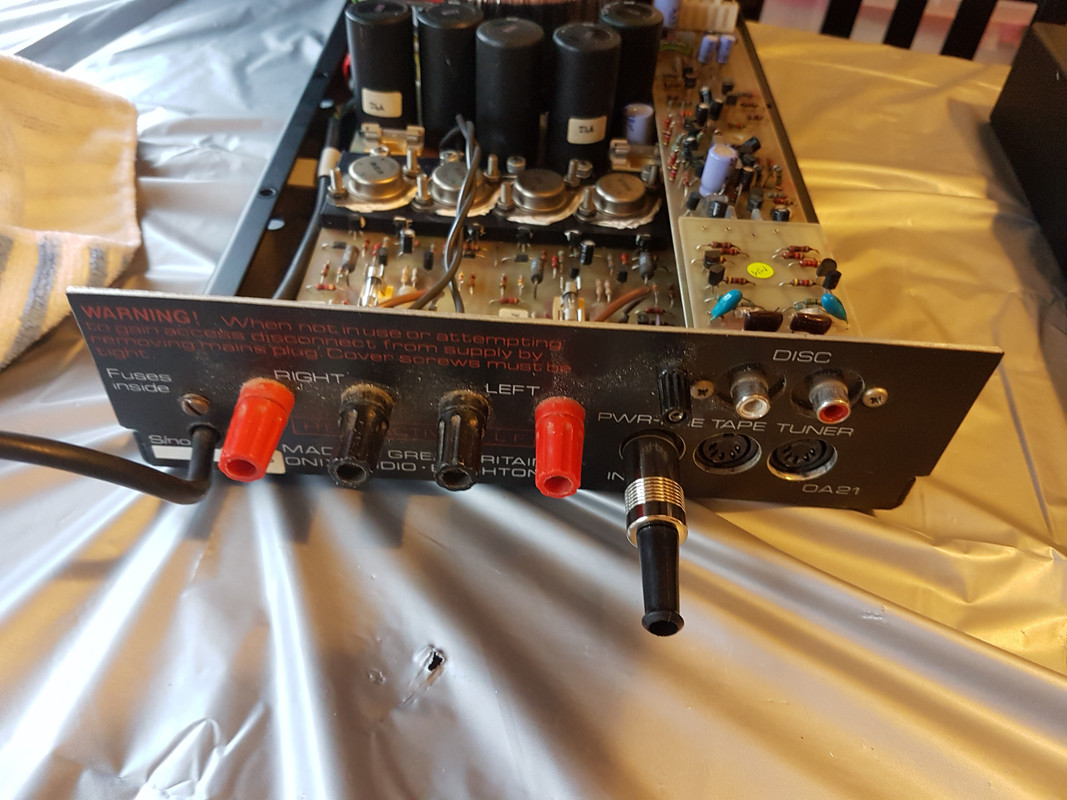
One can certainly understand why they switched from the 6" wide case of the original OA20 to an 8" wide one for OA21; supposedly the same 75wpc amplifier within!:
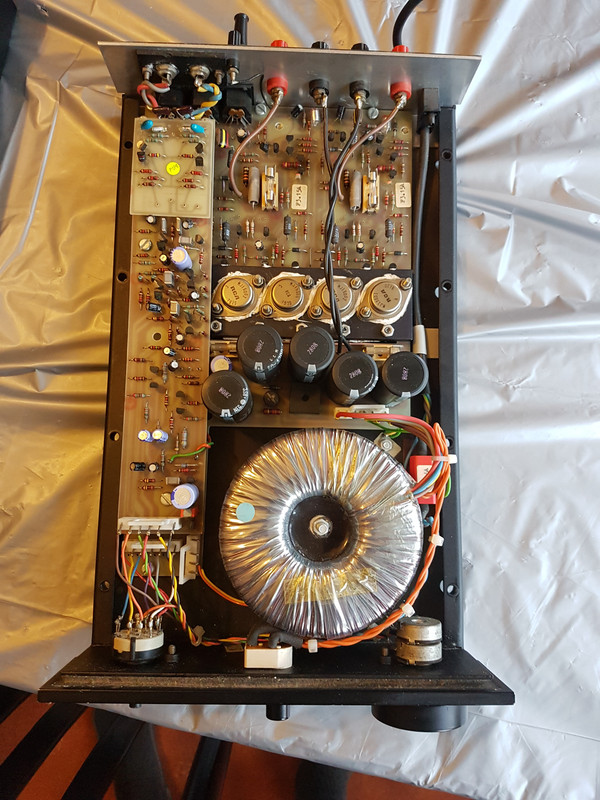
Last edited:
Mine is an OA21E, fully renovated by ONIX in 2017...I have to say it does sound rather good, knocks my Audiolab 8000a into a cocked hat.
I got my oa21s serviced by @Arkless Electronics and it sounds fabulous!
Bad Parameter
pfm Member
Yah, James.
My friend now uses an external passive pre with that "power in" input. Plays beautifully!
Isn't the Onix's preamp circuit passive? At least the OA21E? Have I got it wrong? I need to look again at picts of the insides but I don't think it has an active pre.
tenpercenter
Don't ya rile 'em.....
I don't see a date or the S/N on this one, however, it was listed for sale as OA21A over on thefartofsound.com in Sept 2017. The one I posted the picture of in #30 yesterday appears to be S/N 1005.
According to tony-brady.com, OA21A through E were produced from 1982 through 1989. Yours could be either 'A' or 'B' as, among other changes, TB mentions that OA21C introduced SOAP external power supply compatibility. I suppose the tell would be the absence ('A') or presence ('B') of an LM317T as regulator on the pre-amp supply.
OA21A, note the DIN link plug with rubber boot still on:

One can certainly understand why they switched from the 6" wide case of the original OA20 to an 8" wide one for OA21; supposedly the same 75wpc amplifier within!:

Just noticed a sticker inside the amp that states the manufacturing date and the letter B
There is also a receipt which suggests it was bought from “Brighton Cassette and Hifi” . I bought it from the original owner.
Stuart Frazer
pfm Member
Isn't the Onix's preamp circuit passive? At least the OA21E? Have I got it wrong? I need to look again at picts of the insides but I don't think it has an active pre.
My understanding is that all OA21 variants preamp stages are passive. The LM317T / Gyrator power supply is probably for the phono stage board.
Last edited:
Craig B
Re:trophile
I don't know, Stuart, the 'A' or 'B' variant pictured in post #50 above certainly appears to have a lot of circuitry related to both the input switching and volume pot; so much so that it appears to be split between the LH side of the main board and all of the daughter board that resides above on the left (plus the card labelled 'MM' above that). Regardless, it would take some effort to count up all of the transistors. Surely a passive pre plus active phono input would involve much less than this.My understanding is that all OA21 variants preamp stages are passive. The LM317T / Gyrator power supply is probably for the phono stage board.
Here's @awl's 'E' with phono board removed, revealing the relay switching that had been in use since 'C' (according to your Tony Brady related post above); certainly looks quite simplified compared to 'A' or 'B' above.
Andrew's thread makes for interesting reading wrt what that 317 voltage regulator does (and doesen't do)... https://pinkfishmedia.net/forum/threads/onix-amp-help-with-diagnosis.103287/
Unfortunately, Google returns nothing of 'C' or 'D', let alone any lid off pics.
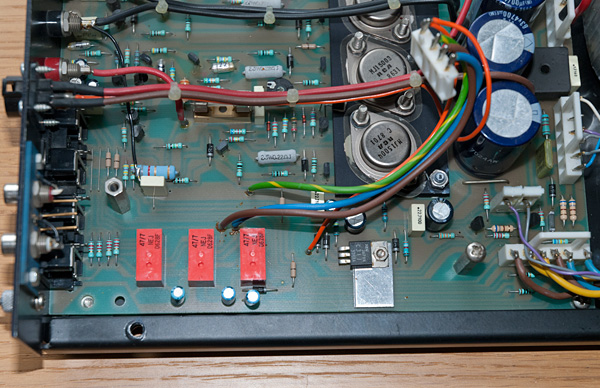
Last edited:
Craig B
Re:trophile
Here's something interesting; a late OA21S line level only version. I'd heard tell of OA22 line level only, but not 21S. Certainly looks quite passive over on the pre side...
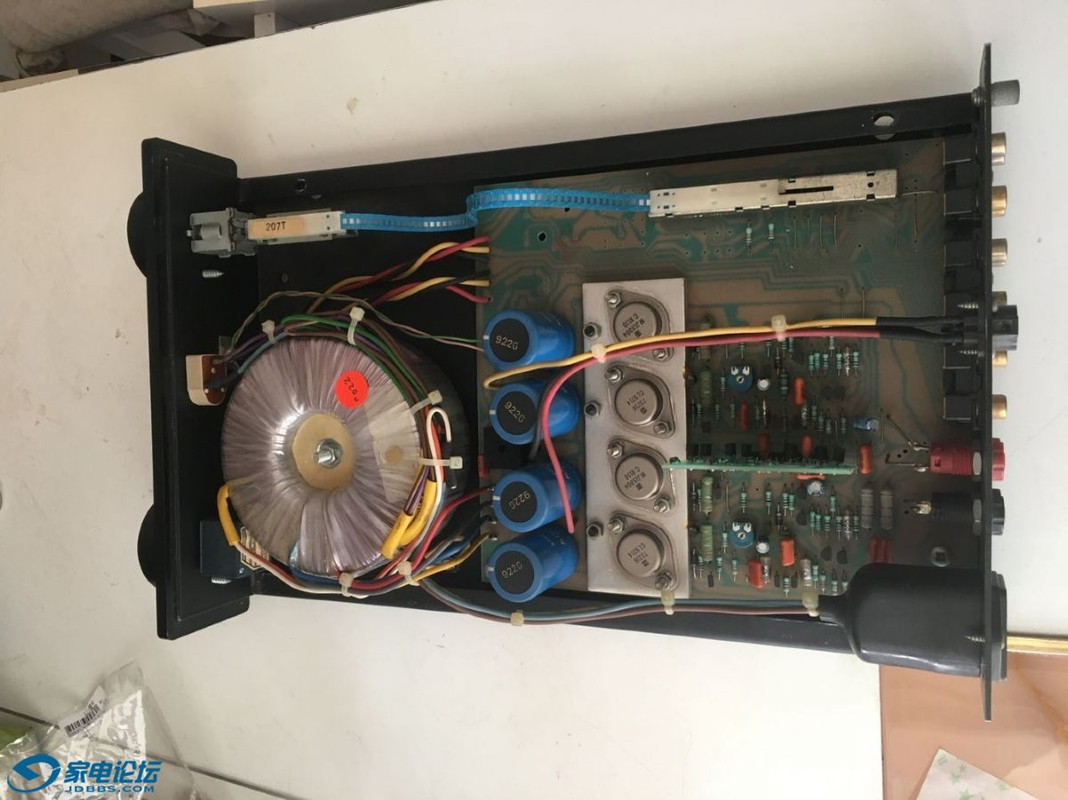
In the following pic, the rear of the unit can be seen to indicate 'AUX' for the right most input, with two red sticker dots covering over what likely says 'DISC' (although there doesn't appear to be any facility within to fit, let alone power a phono board).
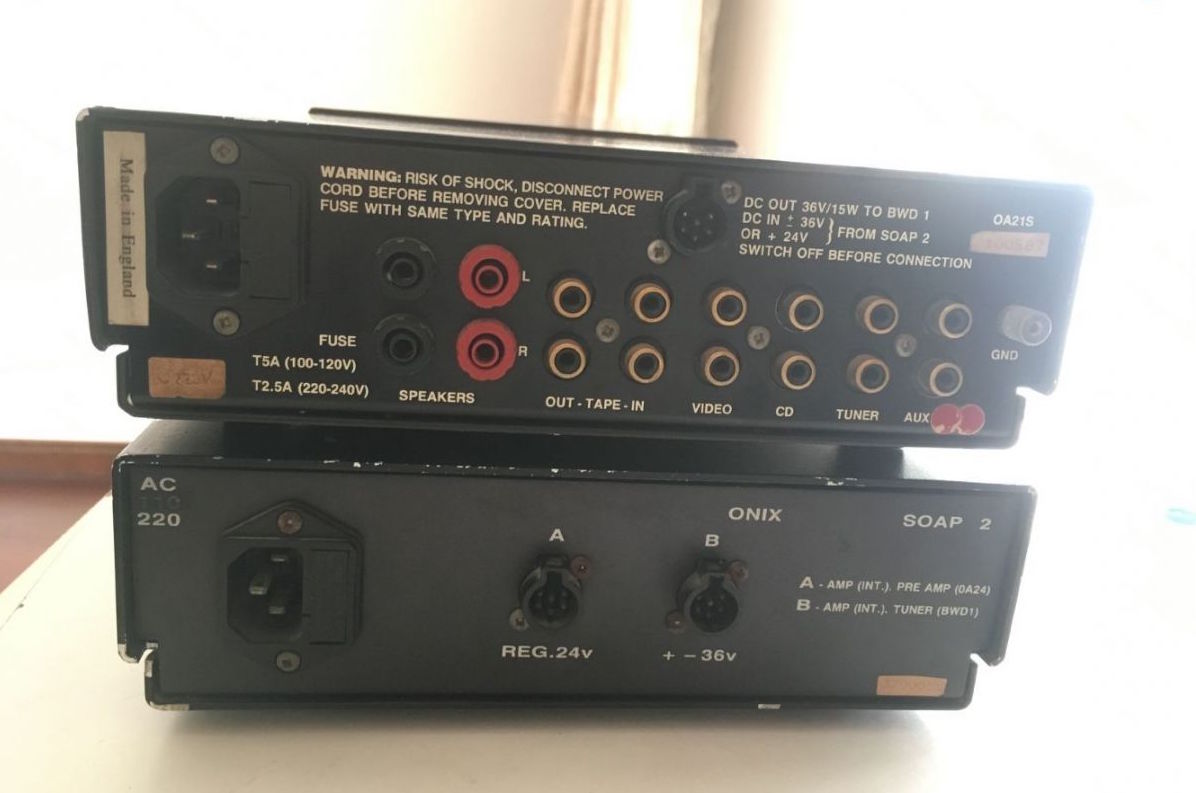

In the following pic, the rear of the unit can be seen to indicate 'AUX' for the right most input, with two red sticker dots covering over what likely says 'DISC' (although there doesn't appear to be any facility within to fit, let alone power a phono board).

Stuart Frazer
pfm Member
That will be the OA22/2 - 1992 - 1995 - line only version built on a OA21S pcb
Craig B
Re:trophile
That's what I thought at first glance too, Stuart. Apparently OA22/2 was a built down power supply and output transistor variant, and with no SOAP upgrade option. Otherwise, it appears to be the same amp circuit on the same pcb, but with 30wpc vs. the 50wpc of OA21C through S.That will be the OA22/2 - 1992 - 1995 - line only version built on a OA21S pcb
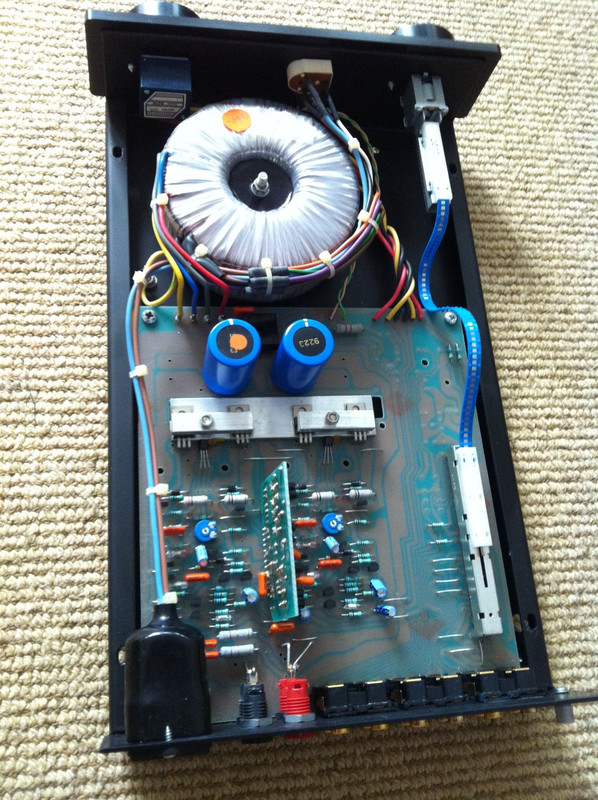
Stuart Frazer
pfm Member
That's what I thought at first glance too, Stuart. Apparently OA22/2 was a built down power supply and output transistor variant, and with no SOAP upgrade option. Otherwise, it appears to be the same amp circuit on the same pcb, but with 30wpc vs. the 50wpc of OA21C through S.

That's interesting Craig. So the OA22/2 had power supply changes - reduced capacitor sizing and different output transistors. No phono stage either, but an extra input. The OA21s photos you posted above seem to show a 21s without the phono stage. I wonder if this could be specified or perhaps this was maybe a special build, staff build or such.
I have a model OA21C - I will dig out some internal photos to post.
Craig B
Re:trophile
Based solely upon my memories of what the popular brands were doing into the early/mid '90s, I think Onix were following the general trend of offering increasing numbers of line level inputs, and/or noticing the proliferation of line level only integrateds, and/or possibly maintaining and/or attempting to increase market share/profits by recognizing that the bottom had nearly fallen out of turntable sales (at least for a stretch). Just a guess.That's interesting Craig. So the OA22/2 had power supply changes - reduced capacitor sizing and different output transistors. No phono stage either, but an extra input. The OA21s photos you posted above seem to show a 21s without the phono stage. I wonder if this could be specified or perhaps this was maybe a special build, staff build or such.
Both the line-level only OA21S and OA20/2 models pictured above appear to be late (last?) versions; one clue being what appear to be panel mounted BFA connector compatible speaker sockets. Most of the OA21S pics indicate standard Deltron board mounted stacked sockets, same as the earlier OA20/2 (more later).
That would be fantastic, Stuart. 'C' and 'D' are the missing links, although it would be great to find some lid off pics of an original OA20 in 6" wide casework too.I have a model OA21C - I will dig out some internal photos to post.
Pending permission from the pfm main bridge, I'd like to put together an FAQ, including photos, that covers shoebox Onix integrated amps on here. Perhaps Tony Brady won't mind allowing a portion of his tony-brady.com recollections to be included, along with the extra details that you posted above?


